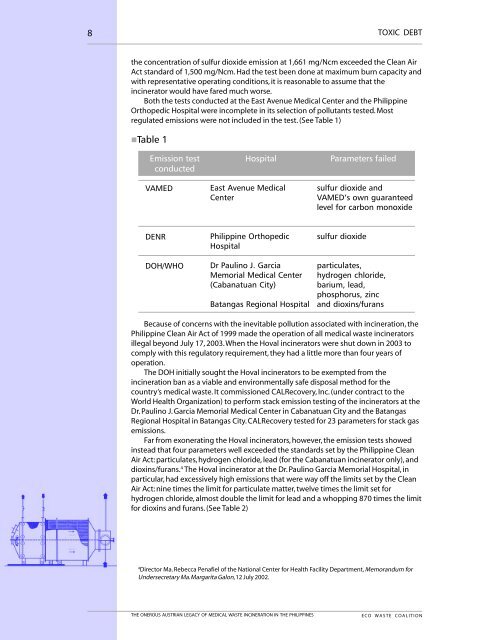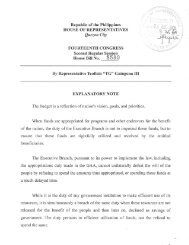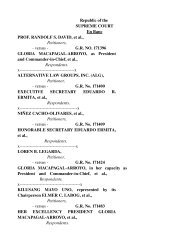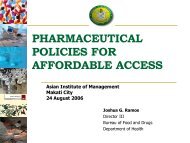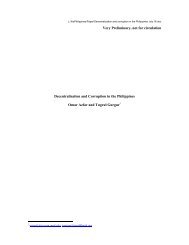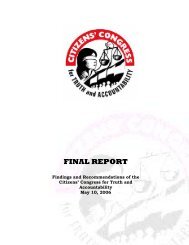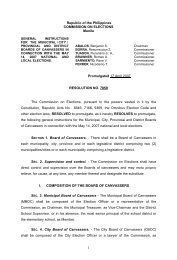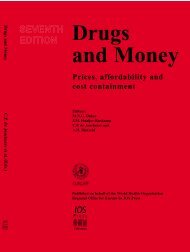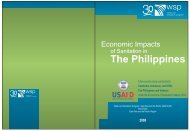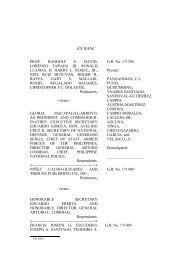Ecowaste Coalition - Philippine Center for Investigative Journalism
Ecowaste Coalition - Philippine Center for Investigative Journalism
Ecowaste Coalition - Philippine Center for Investigative Journalism
Create successful ePaper yourself
Turn your PDF publications into a flip-book with our unique Google optimized e-Paper software.
8<br />
TOXIC DEBT<br />
the concentration of sulfur dioxide emission at 1,661 mg/Ncm exceeded the Clean Air<br />
Act standard of 1,500 mg/Ncm. Had the test been done at maximum burn capacity and<br />
with representative operating conditions, it is reasonable to assume that the<br />
incinerator would have fared much worse.<br />
Both the tests conducted at the East Avenue Medical <strong>Center</strong> and the <strong>Philippine</strong><br />
Orthopedic Hospital were incomplete in its selection of pollutants tested. Most<br />
regulated emissions were not included in the test. (See Table 1)<br />
Table 1<br />
Emission test<br />
conducted<br />
VAMED<br />
Hospital<br />
East Avenue Medical<br />
<strong>Center</strong><br />
Parameters failed<br />
sulfur dioxide and<br />
VAMED’s own guaranteed<br />
level <strong>for</strong> carbon monoxide<br />
DENR<br />
DOH/WHO<br />
<strong>Philippine</strong> Orthopedic<br />
Hospital<br />
Dr Paulino J. Garcia<br />
Memorial Medical <strong>Center</strong><br />
(Cabanatuan City)<br />
Batangas Regional Hospital<br />
sulfur dioxide<br />
particulates,<br />
hydrogen chloride,<br />
barium, lead,<br />
phosphorus, zinc<br />
and dioxins/furans<br />
Because of concerns with the inevitable pollution associated with incineration, the<br />
<strong>Philippine</strong> Clean Air Act of 1999 made the operation of all medical waste incinerators<br />
illegal beyond July 17, 2003. When the Hoval incinerators were shut down in 2003 to<br />
comply with this regulatory requirement, they had a little more than four years of<br />
operation.<br />
The DOH initially sought the Hoval incinerators to be exempted from the<br />
incineration ban as a viable and environmentally safe disposal method <strong>for</strong> the<br />
country’s medical waste. It commissioned CALRecovery, Inc. (under contract to the<br />
World Health Organization) to per<strong>for</strong>m stack emission testing of the incinerators at the<br />
Dr. Paulino J. Garcia Memorial Medical <strong>Center</strong> in Cabanatuan City and the Batangas<br />
Regional Hospital in Batangas City. CALRecovery tested <strong>for</strong> 23 parameters <strong>for</strong> stack gas<br />
emissions.<br />
Far from exonerating the Hoval incinerators, however, the emission tests showed<br />
instead that four parameters well exceeded the standards set by the <strong>Philippine</strong> Clean<br />
Air Act: particulates, hydrogen chloride, lead (<strong>for</strong> the Cabanatuan incinerator only), and<br />
dioxins/furans. 4 The Hoval incinerator at the Dr. Paulino Garcia Memorial Hospital, in<br />
particular, had excessively high emissions that were way off the limits set by the Clean<br />
Air Act: nine times the limit <strong>for</strong> particulate matter, twelve times the limit set <strong>for</strong><br />
hydrogen chloride, almost double the limit <strong>for</strong> lead and a whopping 870 times the limit<br />
<strong>for</strong> dioxins and furans. (See Table 2)<br />
4<br />
Director Ma. Rebecca Penafiel of the National <strong>Center</strong> <strong>for</strong> Health Facility Department, Memorandum <strong>for</strong><br />
Undersecretary Ma. Margarita Galon, 12 July 2002.<br />
THE ONEROUS AUSTRIAN LEGACY OF MEDICAL WASTE INCINERATION IN THE PHILIPPINES<br />
ECO WASTE COALITION


